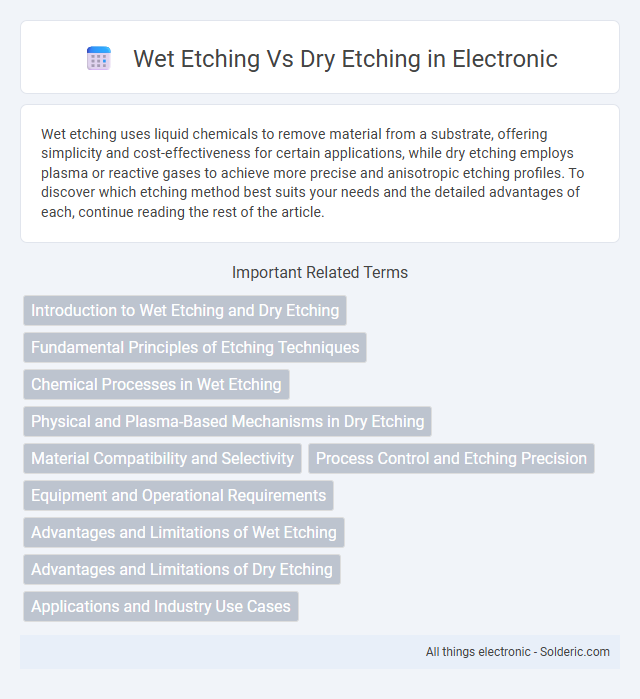Wet etching uses liquid chemicals to remove material from a substrate, offering simplicity and cost-effectiveness for certain applications, while dry etching employs plasma or reactive gases to achieve more precise and anisotropic etching profiles. To discover which etching method best suits your needs and the detailed advantages of each, continue reading the rest of the article.
Comparison Table
| Aspect | Wet Etching | Dry Etching |
|---|---|---|
| Process Type | Chemical solution-based etching | Plasma or gas-based etching |
| Material Removal | Isotropic (uniform in all directions) | Anisotropic (directional control) |
| Common Chemicals/Gases | Acids, bases (e.g., HF, HCl) | Fluorine, chlorine, oxygen-based plasmas |
| Precision | Lower precision, rough edges | High precision, sharp profiles |
| Application | Simple patterning, bulk etching | Microfabrication, fine features |
| Control | Challenging to control depth and uniformity | Excellent control over depth and anisotropy |
| Environmental Impact | Generates liquid chemical waste | Produces gaseous byproducts |
| Cost | Lower equipment cost | Higher equipment and operation cost |
| Safety | Hazardous chemical handling needed | Requires plasma and gas safety measures |
Introduction to Wet Etching and Dry Etching
Wet etching uses liquid chemicals to selectively remove material from a substrate, offering high etch rates and isotropic profiles ideal for certain microfabrication processes. Dry etching employs plasma or reactive gases to achieve precise, anisotropic patterns with better control over feature dimensions and sidewall profiles. Your choice between wet and dry etching depends on factors such as material compatibility, desired etch precision, and process complexity.
Fundamental Principles of Etching Techniques
Wet etching uses liquid chemicals to selectively dissolve material from a substrate, relying on chemical reactions and diffusion processes to remove targeted layers, which makes it suitable for isotropic etching patterns. Dry etching employs gases or plasmas, utilizing physical ion bombardment and chemical reactions under controlled environments to precisely etch features with anisotropic profiles. Your choice between wet and dry etching depends on factors such as desired etch precision, material compatibility, and process control requirements.
Chemical Processes in Wet Etching
Wet etching relies on liquid chemical solutions to selectively remove material from a substrate by dissolving specific layers through chemical reactions. The process involves immersing the substrate in etchants such as acids or bases that react with the target material, causing a controlled material removal and shaping based on the etchant's selectivity. This approach allows precise pattern transfer at the molecular level by exploiting differences in chemical reactivity between materials.
Physical and Plasma-Based Mechanisms in Dry Etching
Dry etching employs plasma-based mechanisms that physically and chemically remove material through ion bombardment and reactive species interaction, offering precise anisotropic etching compared to wet etching's isotropic chemical dissolution. The physical component in dry etching uses ionized gas particles accelerated towards the substrate to sputter away material, while chemical reactions from plasma-generated radicals enhance selectivity and control in microfabrication. Understanding these plasma-driven physical mechanisms enables you to optimize etching profiles for advanced semiconductor device manufacturing with high resolution and minimal substrate damage.
Material Compatibility and Selectivity
Wet etching offers high selectivity and excellent material compatibility with isotropic removal of silicon dioxide, silicon nitride, and metals like aluminum using chemical solutions such as hydrofluoric acid and nitric acid. Dry etching, including reactive ion etching (RIE), provides anisotropic etching with superior control over pattern fidelity, compatible with a broader range of materials like polysilicon, silicon carbide, and various metals through plasma chemistries. Material selectivity in dry etching is tunable by adjusting gas mixtures and plasma conditions, enabling precise etch profiles critical for microfabrication processes.
Process Control and Etching Precision
Wet etching offers less precise process control due to its reliance on chemical reactions in liquid, often resulting in isotropic etching with undercutting. Dry etching utilizes plasma or reactive gases, providing superior anisotropic etching and finer control over etch profiles, essential for high-resolution patterning. Your choice between wet and dry etching significantly impacts the precision and predictability of microfabrication processes.
Equipment and Operational Requirements
Wet etching requires chemical baths and simple equipment such as tanks, pumps, and rinsing stations, making it cost-effective and straightforward but posing challenges with handling hazardous liquids and waste disposal. Dry etching involves complex plasma reactors, gas delivery systems, and vacuum chambers, demanding higher initial investment and maintenance but offering superior precision and anisotropic etching capabilities. Operationally, wet etching is faster with easier scalability, while dry etching requires precise control of process parameters like gas flow, pressure, and RF power to achieve desired etch profiles.
Advantages and Limitations of Wet Etching
Wet etching offers high selectivity and uniform etching rates, making it ideal for large-area material removal in semiconductor fabrication. Its main advantages include simplicity, low cost, and compatibility with various materials, but limitations arise from isotropic etching, which reduces feature precision and control. Your choice depends on whether fine pattern resolution or overall process efficiency is the priority.
Advantages and Limitations of Dry Etching
Dry etching offers precise pattern transfer and superior anisotropy, enabling intricate microfabrication with high resolution. Its limitations include potential damage to sensitive materials due to plasma exposure and higher equipment costs compared to wet etching. Your choice of dry etching can enhance device performance where fine feature control is essential despite these challenges.
Applications and Industry Use Cases
Wet etching is widely used in microfabrication for bulk material removal in semiconductor manufacturing, MEMS devices, and PCB fabrication due to its cost-effectiveness and simplicity. Dry etching, including plasma and reactive ion etching, excels in creating precise, anisotropic patterns essential for advanced semiconductor devices, nanotechnology, and photonics applications. Your choice depends on required etch resolution, material compatibility, and industry-specific demands, with dry etching preferred for high-precision industry use cases.
Wet Etching vs Dry Etching Infographic

 solderic.com
solderic.com